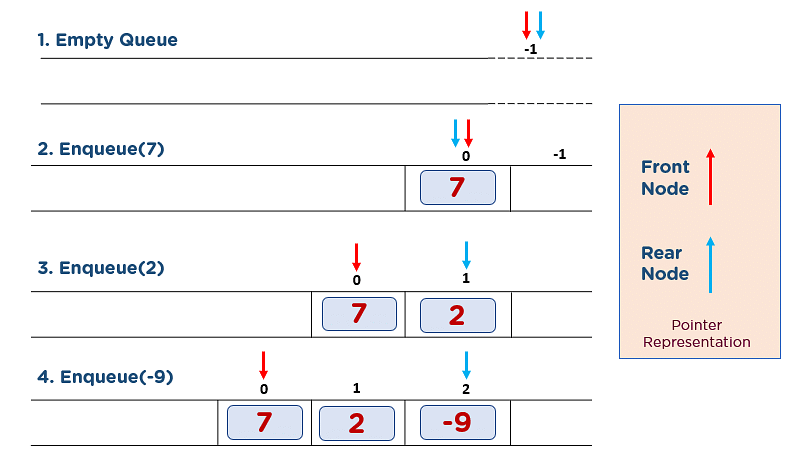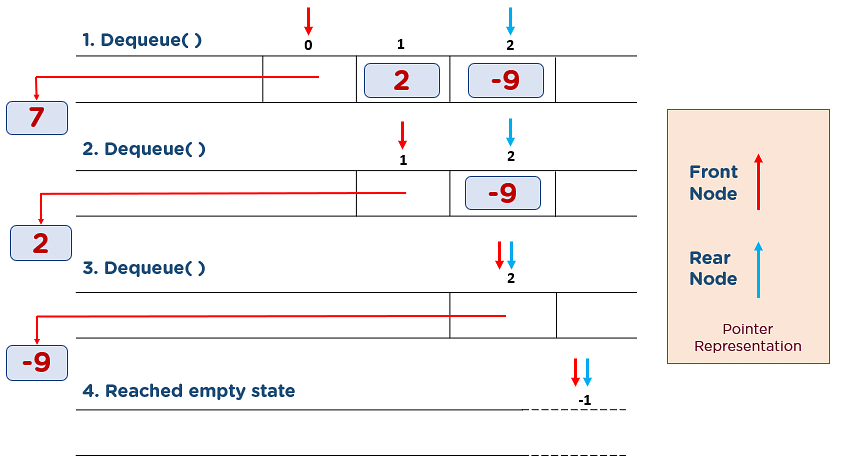Operation on Queue
1) create:
Creates and initializes new queue that is empty, it does not require any parameter and returns an empty queue.
2) Enqueue:
Add a new element to the rear of queue . It requires the element to be added and returns nothing
Step 1: Check if the queue is full.
Step 2: If the queue is full, Overflow error.
Step 3: If the queue is not full, increment the rear pointer to point to the next available empty space.
Step 4: Add the data element to the queue location where the rear is pointing.
Step 5: Here, you have successfully added 7, 2, and -9.

2) Dequeue:
removes the elements from the front of queue. It does not require any parameters and returns the deleted item.
Step 1: Check if the queue is empty.
Step 2: If the queue is empty, Underflow error.
Step 3: If the queue is not empty, access the data where the front pointer is pointing.
Step 4: Increment front pointer to point to the next available data element.
Step 5: Here, you have removed 7, 2, and -9 from the queue data structure.

Footer Design
Add a new element to the rear of queue . It requires the element to be added and returns nothing
Step 1: Check if the queue is full.
Step 2: If the queue is full, Overflow error.
Step 3: If the queue is not full, increment the rear pointer to point to the next available empty space.
Step 4: Add the data element to the queue location where the rear is pointing.
Step 5: Here, you have successfully added 7, 2, and -9.

2) Dequeue:
removes the elements from the front of queue. It does not require any parameters and returns the deleted item.
Step 1: Check if the queue is empty.
Step 2: If the queue is empty, Underflow error.
Step 3: If the queue is not empty, access the data where the front pointer is pointing.
Step 4: Increment front pointer to point to the next available data element.
Step 5: Here, you have removed 7, 2, and -9 from the queue data structure.

Footer Design
Step 2: If the queue is full, Overflow error.
Step 3: If the queue is not full, increment the rear pointer to point to the next available empty space.
Step 4: Add the data element to the queue location where the rear is pointing.
Step 5: Here, you have successfully added 7, 2, and -9.

2) Dequeue:
removes the elements from the front of queue. It does not require any parameters and returns the deleted item.
Step 1: Check if the queue is empty.
Step 2: If the queue is empty, Underflow error.
Step 3: If the queue is not empty, access the data where the front pointer is pointing.
Step 4: Increment front pointer to point to the next available data element.
Step 5: Here, you have removed 7, 2, and -9 from the queue data structure.

Footer Design
Step 1: Check if the queue is empty.
Step 2: If the queue is empty, Underflow error.
Step 3: If the queue is not empty, access the data where the front pointer is pointing.
Step 4: Increment front pointer to point to the next available data element.
Step 5: Here, you have removed 7, 2, and -9 from the queue data structure.

Footer Design
Step 2: If the queue is empty, Underflow error.
Step 3: If the queue is not empty, access the data where the front pointer is pointing.
Step 4: Increment front pointer to point to the next available data element.
Step 5: Here, you have removed 7, 2, and -9 from the queue data structure.
